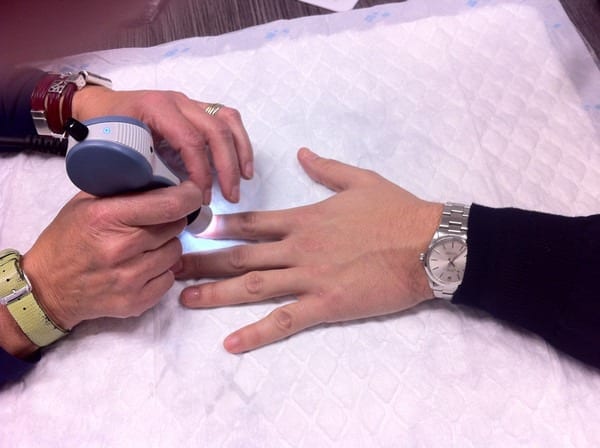
A novel way to count white blood cells without a blood test, simply by applying a small device on the fingertip, is being developed by a team of young bioengineers. The technology, that combines an optical sensor with algorithms, has already three prototypes on the go and is specially designed to be used on chemotherapy patients, who could know their immune system levels in real time. It could also serve to detect serious infections.
A group of young bioengineers from various countries, including Spaniard Carlos Castro, is developing a portable device capable of counting white blood cells in real time, without requiring a blood test. The system includes an innovative optics sensor through the skin that can observe white cells as they flow past a miniature lens. This new device –potentially on the market in 2019– could be applied to improve the treatment of patients who are left immunosuppressed after chemotherapy treatments and to prevent sepsis.
The system includes an innovative optics sensor through the skin that can observe white cells as they flow past a miniature lens
The project, known as Leuko, has been financed by Madrid-MIT M+Visión, a consortium that seeks to catalyse collaboration between research centres and hospitals in the region of Madrid with the Massachusetts Institute of Technology (MIT) and other centres in the Boston area (USA). Two other USA institutions have also supported the project: the Center of Future Technologies in Cancer Care and the Coulter Foundation. The total amount raised to develop this idea has been 400,000 euros.
Carlos Castro, an engineer specialised in biomedicine working in the Research Laboratory of Electronics at MIT, tells Sinc that the new device “will allow white blood cells to be measured simply and painlessly. The same way diabetics nowadays have a glucometer to check their glucose levels, patients undergoing chemotherapy will be able to use a ‘leukometer’ in the future to estimate the state of their immune system.”
Lymphoma and leukaemia
This technology –Castro adds– opens up the possibility to personalize chemotherapy treatment according to the immunological response for each patient. Particularly, in the case of patients with lymphomas and leukaemia, “treatment doses could be maximised for each individual without compromising their immunological system. Treatment efficiency could be improved while reducing the risk of suffering serious infections.”
The engineer tells that the idea came up during a clinical visit the team conducted at Hospital Gregorio Marañón, in Madrid, two years ago. The researchers observed that immunosuppression (low white blood cell counts) is the main side effect for chemotherapy patients, which leads to possible infections, hospitalizations, treatment delays and shorter life expectancy.
Immunosuppression (low white blood cell counts) is the main side effect after chemotherapy
From that moment, “we saw the need to create a non-invasive device that would detect leukopenia earlier and avoid its consequences,” he says.
According to the expert, the technology includes a portable optical system, which provides oblique illumination with LEDs, and is able to capture images of superficial capillaries under the skin with cellular resolution. The acquired videos are subsequently analysed by automatic algorithms capable of detecting white blood cells and calculating their concentration. These algorithms, which have been protected by a patent filing, were presented at the Annual International Conference of the IEEE Engineering in Medicine and Biology Society, held in Milan in August.
How to use
Castro explains that the device is placed on the patient’s fingertip, in a similar way to how pulse oximeters are used in hospitals to measure blood oxygen levels. With a small lens, the system captures images of capillaries very close to the surface in the nailbed.
When illuminating at certain frequencies, light is absorbed by the haemoglobin in the red cells, an effect that does not happen with the white cells. This means that the leukocytes appear as small transparent particles moving inside the capillary.
With this technology leukocytes appear as small transparent particles moving inside the capillary
Subsequently, “our image processing algorithms recognise these events and count them, providing an estimate for their concentration in the blood,” adds the researcher. In his opinion, this easy-to-use and portable device will allow the patients to carry out these measurements at home in the future. It will no longer be necessary for them to travel to a hospital or clinic. “In rural areas where access to health centres is limited, or in developing countries, this becomes a huge advantage. It would also be possible to perform measurements on a continuous basis, opening up treatment options that were previously not possible,” he highlights.
Personalized treatments
For example, if white blood cells were detected to be too low for a chemotherapy patient, medication could be immediately prescribed to boost his levels and avoid a potential infection. On the other hand, if a patient is observed to recover earlier than anticipated, he could be administered a new dose of his treatment and shorten his recovery time. “These decisions are not currently possible because it is not feasible to call patients in every hour or every day to test their blood”, says Castro.
The engineer says that, in addition to its application in chemotherapy, “there are other medical areas where this device could have a great impact, from preventing sepsis to the early diagnosis of a bacterial or viral infection which threatens 4 billion people worldwide.”
Read more: New portable device counts leukocytes through the skin
The Latest on: New portable device counts leukocytes through the skin
[google_news title=”” keyword=”New portable device counts leukocytes through the skin” num_posts=”10″ blurb_length=”0″ show_thumb=”left”]
via Google News
The Latest on: New portable device counts leukocytes through the skin
- Skin in the game: the latest issue of Medical Technology is out nowon May 9, 2024 at 10:09 am
In this month’s edition, we spotlight an emerging technology in the skin cancer space. Engineers Ali Khachlouf and Tanguy Serrat, co-founders of Squaremind, have developed a game-changing concept: ...
- Scientists discover new type of cell in the liveron May 9, 2024 at 6:49 am
Scientists have discovered a new type of cell in the liver that plays a critical role in repairing damage. These "leader cells" are responsible for dragging healthy tissue into wounds as they heal ...
- Development of ultra-high-efficiency pure red light-emitting devices with enhanced color representationon May 8, 2024 at 6:38 am
and smart wearable device development." More information: Kyunghoon Lee et al, Highly efficient pure red light-emitting diodes through surface bromination of CsPbI3 perovskite nanocrystals for ...
- Climate and Environmenton May 8, 2024 at 3:58 am
Experts say that a new wave of electric vehicle charging stations ... where colorful birds roost on tangled branches and trunks, and small paths through the greenery beckon.
- What Is Hypochlorous Acid—And Is It Good for Skin?on May 2, 2024 at 5:00 pm
In other words, if you have sensitive skin and are cautious about introducing new ... through a dermatologist. You can also use a few over-the-counter hypochlorous acid sprays. Facial sprays are ...
- We’re in Our Feels — Bubble Skincare’s New Collection With Pixar’s Inside Out 2 Can Help Combo Skin Through Its Ups & Downson May 2, 2024 at 12:30 pm
Just hear me out for a sec: when your skin continuously goes through changes and breakouts ... Take a peek at the new collection below, and find the products that’ll help you (and your teens ...
- Toxic chemicals from microplastics can be absorbed by the skin, study findson April 25, 2024 at 5:00 pm
Share on Pinterest A new study demonstrates ... are absorbed by the skin. The findings demonstrate that several flame-retardant additives passed through the skin barrier. Research is moving ...
- A new wave of wearable devices will harvest a mountain of personal dataon April 18, 2024 at 11:49 am
Today, there are portable devices to obtain high-quality data from brain activity, eye trackers, and the skin (to detect temperature ... up our hands and require new kinds of interaction with ...
- The 7 best cell phones of 2024 go way, way beyond talking and textingon April 18, 2024 at 11:01 am
They're powerful communications, productivity, fitness and entertainment devices -- plus ... but we recommend going through one of the cellular service providers below. The new OnePlus 12R is ...
- New device can treat injury from sepsison April 12, 2024 at 5:00 pm
It can selectively calm the excessively activated white blood cells within ... intensive care. The device is attached to a pump system outside the body, which pumps blood through the device.
via Bing News










